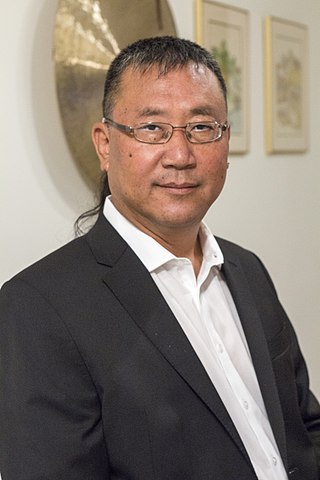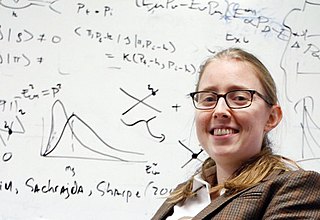
Ben Roy Mottelson was an American-Danish nuclear physicist. He won the 1975 Nobel Prize in Physics for his work on the non-spherical geometry of atomic nuclei.
Charles Young Prescott is an American particle physicist.

Chang Kee Jung is a physicist and professor at Stony Brook University. He was recognized as a State University of New York (SUNY) Distinguished Professor in 2015, and received a SUNY Chancellor's Award for Excellence in Scholarship and Creative Activities in 2014.
Andrei Nickolay Slavin from the Oakland University, Rochester, MI is a fellow of the American Physical Society (2009) and was also named Fellow of the Institute of Electrical and Electronics Engineers (IEEE) in 2012 for contributions to magnetic excitations and magnetization dynamics induced by spin transfer.
Faqir Chand Khanna from the University of Victoria, was awarded the status of Fellow in the American Physical Society, after he was nominated by their Division of Nuclear Physics in 1983, for his work on effective operators which had led to deeper understanding of physical phenomena in a broad range of many-body problems including quasiparticle aspects in nuclear structure, the interplay between nucleons and mesons, and excitation in normal liquid He..
Werner Sandhas was a German physicist at the University of Bonn.
Jerome Lewis Duggan was a Regents Professor at the University of North Texas (UNT), the founder of the International Conference on the Application of Accelerators in Research and Industry (CAARI). He was also a Fellow in the American Physical Society.
Victor Valentine Eremenko from the Institute For Low Temperature Physics, was awarded the status of Fellow in the American Physical Society, after they were nominated by their Forum on International Physics in 2000, for pioneering works in magneto-optics of antiferromagnets, discovery of the ""mixed"" and ""intermediate"" states of antiferromagnets near magnetic phase transitions, photoinduced persistent phenomena in magnetic insulators & high-Tc superconductors; and his international activities as the editor of ""Low Temperature""
Ruben Gerardo Barrera is a Mexican physicist, professor emeritus at the National Autonomous University of Mexico (UNAM). His main interest has been the optical properties of inhomogeneous systems.
Leonid Lev Frankfurt is a Russian-Israeli physicist from Tel Aviv University. He was awarded the status of Fellow in the American Physical Society, after they were nominated by their Division of Nuclear Physics in 2007, for seminal contributions to high energy and high momentum transfer probes of hadrons and nuclei including: inventing the additive quark model, deriving the light front approach to nuclei, showing how to observe nucleon-nucleon corrections, and discovery of high-energy color transparency.
Noemi Mirkin from the University of Michigan, was awarded the status of Fellow in the American Physical Society, after they were nominated by their Forum on International Physics in 2007, for her leadership in establishing productive international collaborations, her many achievements in biological molecular physics and for her long service to the international community as an officer and Executive Committee member of the Forum on International Physics.
László András Baksay was a Hungarian physicist and academic. He was a former professor and head of the Physics and Space Sciences at the Department of Physics and Space Sciences at the Florida Institute of Technology.
Xincheng Xie is a professor of physics and Dean, School of Physics, Peking University.
Daniel Phillips from Ohio University, was awarded the status of Fellow in the American Physical Society, after they were nominated by their Topical Group on Few-Body Systems in 2008, for "his research on effective hadronic theories of few-nucleon systems, especially on the role of the Delta (1232) and the description of electromagnetic reactions on light nuclei, and their application in obtaining reliable information on neutron properties from experimental data."
Elena Amanda Long is assistant professor of physics at the University of New Hampshire and is an activist for LGBT people in science. The journal Nature called her a "diversity trailblazer" in their Nature's 10: Ten people who mattered this year in 2016. Long's research on the internal structure of nucleons earned her a 2015 Jefferson Science Associates (JSA) Promising Young Scientist award. Long has made significant contributions to improve the inclusion of under-represented researchers and students by founding the LGBT+ Physics organisation and serving as a member of the American Physical Society (APS) Committee of LGBT Issues.
Elizabeth J. (Betsy) Beise is a Professor of Physics and Associate Provost at the University of Maryland, College Park. She works on quantum chromodynamics, nucleon structure and fundamental symmetries.
Xiangdong Ji is a Chinese theoretical nuclear and elementary particle physicist.

Phiala Elisabeth Shanahan is an Australian theoretical physicist who lives and works in the United States. She is known for her work on the structure and interactions of hadrons and nuclei and her innovative use of machine learning techniques in lattice quantum field theory calculations.

Volker D. Burkert is a German physicist, academic and researcher. He is a Principal Staff Scientist at the Thomas Jefferson National Accelerator Facility at Jefferson Lab (JLab) in Newport News, Virginia (USA). He has made major contributions to the design of the CEBAF Large Acceptance Spectrometer (CLAS) that made it suitable for high luminosity operation in experiments studying spin-polarized electron scattering.
Calvin Rudolph Howell is an American physicist and professor at Duke University in Durham, North Carolina.



